Zoning Lubricant Die Application for Improving Formability of Box-Shaped Deep Drawn Parts
Abstract
:1. Introduction
2. Proposed Zoning Lubricant Deep Drawn Die Application and Its Principles
3. FEM Simulation and Experimental Procedures
4. Results and Discussion
4.1. Friction Coefficient Examinations
4.2. Validation of FEM Simulation Use
4.3. Comparison of Material Flow Analysis between Conventional and Zoning Lubricant Deep Drawing Die Applications
4.4. Confirmation of Zoning Lubricant Die Application
5. Conclusions
Author Contributions
Funding
Institutional Review Board Statement
Informed Consent Statement
Data Availability Statement
Acknowledgments
Conflicts of Interest
References
- Ouyang, Y.; Lee, M.S.; Moon, J.H.; Kang, C.G. The effect of the blank holding force on formability in hot deep drawing of boron steel considering heat transfer phenomena and friction coefficient by simulation and experimental investigation. Proc. Inst. Mech. Eng. Part B J. Eng. Manuf. 2012, 226, 1506–1518. [Google Scholar] [CrossRef]
- Behrens, G.; Trier, F.O.; Tetzel, H.; Vollertsen, F. Influence of tool geometry variations on the limiting drawing ratio in micro deep drawing. Int. J. Mater. Form. 2016, 9, 253–258. [Google Scholar] [CrossRef]
- Kayhan, E.; Kaftanoglu, B. Experimental investigation of non-isothermal deep drawing of DP600 steel. Int. J. Adv. Manuf. Technol. 2018, 99, 695–706. [Google Scholar] [CrossRef]
- Wang, W.; Chen, S.; Tao, K.; Gao, K.; Wei, X. Experimental investigation of limit drawing ratio for AZ31B magnesium alloy sheet in warm stamping. Int. J. Adv. Manuf. Technol. 2017, 92, 723–731. [Google Scholar] [CrossRef]
- Satish, D.R.; Kumar, D.R. Formability of AA6061 alloy sheets in warm forming temperature range. Proc. Inst. Mech. Eng. Part L J. Mater. Des. Appl. 2019, 233, 413–425. [Google Scholar] [CrossRef]
- Şen, N.; Karaağaç, İ.; Kurgan, N. Experimental research on warm deep drawing of HC420LA grade sheet material. Int. J. Adv. Manuf. Technol. 2016, 87, 3359–3371. [Google Scholar] [CrossRef]
- Panicker, S.S.; Panda, S.K. Improvement in material flow during nonisothermal warm deep drawing of nonheat treatable aluminum alloy sheets. J. Manuf. Sci. Eng. 2017, 139, 031013. [Google Scholar] [CrossRef]
- Fallahiarezoodar, A.; Peker, R.; Altan, T. Temperature increase in forming of advanced high-strength steels effect of ram speed using a servodrive press. J. Manuf. Sci. Eng. 2016, 138, 094503. [Google Scholar] [CrossRef]
- Meza-García, E.; Birnbaum, P.; Landgraf, P.; Grund, T.; Lampke, T.; Kräusel, V. Thermomechanical treatment of martensitic stainless steels sheets and its effects on their deep drawability and resulting hardness in press hardening. Metals 2020, 10, 1536. [Google Scholar] [CrossRef]
- Yuan, S.; Cheng, W.; Liu, W.; Xu, Y. A novel deep drawing process for aluminum alloy sheets at cryogenic temperatures. J. Mater. Process. Technol. 2020, 284, 116743. [Google Scholar] [CrossRef]
- Wang, M.; Li, J.; Deng, L.; Li, J. Metal flow control during hot forming of square cups with local-thickened plates and varied friction conditions. J. Mater. Process. Technol. 2018, 253, 195–203. [Google Scholar] [CrossRef]
- Phanitwong, W.; Thipprakmas, S. Parameter design of draw bead in rectangular deep-drawing process using Taguchi technique. Steel Res. Int. 2012, 379–382. [Google Scholar]
- Vasudevan, V.; Bandyopadhyay, K.; Panda, S.K. Influence of anisotropy parameter on deep drawing of tailor welded blanks of low-carbon steels. Proc. Inst. Mech. Eng. Part B J. Eng. Manuf. 2014, 228, 1162–1171. [Google Scholar] [CrossRef]
- Dhaiban, A.A.; Soliman, M.E.S.; El-Sebaie, M. Finite element modeling and experimental results of brass elliptic cups using a new deep drawing process through conical dies. J. Mater. Process. Technol. 2014, 214, 828–838. [Google Scholar] [CrossRef]
- Karajibani, E.; Hashemi, R.; Sedighi, M. Determination of forming limit curve in two-layer metallic sheets using the finite element simulation. Proc. Inst. Mech. Eng. Part L J. Mater. Des. Appl. 2016, 230, 1018–1029. [Google Scholar] [CrossRef]
- Martins, A.L.T.; Couto, A.A.; Lima, N.B. Study of the deep drawing behavior and crystallographic texture of AA 3104-H19 aluminum alloy sheets. Proc. Inst. Mech. Eng. Part L J. Mater. Des. Appl. 2016, 230, 748–759. [Google Scholar] [CrossRef]
- Kesharwani, R.K.; Basak, S.; Panda, S.; Pal, S. Improvement in limiting drawing ratio of aluminum tailored friction stir welded blanks using modified conical tractrix die. J. Manuf. Process. 2017, 28, 137–155. [Google Scholar] [CrossRef]
- Lin, B.T.; Yang, C.Y. Using a punch with micro-ridges to shorten the multistage deep drawing process for stainless steels. Int. J. Adv. Manuf. Technol. 2017, 88, 2693–2703. [Google Scholar] [CrossRef]
- Jalil, A.; Gollo, M.H.; Seyedkashi, S.M.H. Process analysis of hydrodynamic deep drawing of cone cups assisted by radial pressure. Proc. Inst. Mech. Eng. Part B J. Eng. Manuf. 2017, 231, 1793–1802. [Google Scholar] [CrossRef]
- Magrinho, J.P.G.; Silva, C.M.A.; Silva, M.B.; Martins, P.A.F. Formability limits by wrinkling in sheet metal forming. Proc. Inst. Mech. Eng. Part L J. Mater. Des. Appl. 2018, 232, 681–692. [Google Scholar] [CrossRef]
- Zhang, C.B.; Gong, F. Deep drawing of cylindrical cups using polymer powder medium based flexible forming. Int. J. Precis. Eng. Manuf. Green Technol. 2018, 5, 63–70. [Google Scholar] [CrossRef]
- Abe, Y.; Mori, K.I.; Maeno, T.; Ishihara, S.; Kato, Y. Improvement of sheet metal formability by local work-hardening with punch indentation. Prod. Eng. 2019, 13, 589–597. [Google Scholar] [CrossRef]
- Lee, M.S.; Kim, S.J.; Seo, H.Y.; Kang, C.G. Investigation of formability and fiber orientation in the square deep dawing process with Steel/CFRP hybrid composites. Int. J. Precis. Eng. Manuf. Green Technol. 2019, 20, 2019–2031. [Google Scholar] [CrossRef]
- Fazlollahi, M.; Morovvati, M.R.; Dariani, B.M. Theoretical, numerical and experimental investigation of hydro-mechanical deep drawing of steel/polymer/steel sandwich sheets. Proc. Inst. Mech. Eng. Part B J. Eng. Manuf. 2019, 232, 1529–1546. [Google Scholar] [CrossRef]
- Ballikaya, H.; Savas, V.; Ozay, C. The limit drawing ratio in die angled hydromechanical deep drawing method. Int. J. Adv. Manuf. Technol. 2020, 106, 791–801. [Google Scholar] [CrossRef]
- Hajiahmadi, S.; Elyasi, M. Evaluation of drawing force by a new dimensionless method in deep drawing process. Proc. Inst. Mech. Eng. Part B J. Eng. Manuf. 2020, 234, 1604–1614. [Google Scholar] [CrossRef]
- Moghadam, M.; Nielsen, C.V.; Bay, N. Analysis of the risk of galling in sheet metal stamping dies with drawbeads. Proc. Inst. Mech. Eng. Part B J. Eng. Manuf. 2020, 234, 1207–1214. [Google Scholar] [CrossRef]
- Tan, C.J.; Aslian, A. FE simulation study of deep drawing process of SUS304 cups having no delayed cracks under enhanced blank holding force. Proc. Inst. Mech. Eng. Part B J. Eng. Manuf. 2020, 234, 84–94. [Google Scholar] [CrossRef]
- Iorio, L.; Pagani, L.; Strano, M.; Monno, M. Design of Deformable Tools for Sheet Metal Forming. J. Manuf. Sci. Eng. 2016, 138, 094701. [Google Scholar] [CrossRef]
- Lange, K. Handbook of Metal Forming; McGraw-Hill Inc.: New York, NY, USA, 1985; Chapter 20; ISBN 978-0070362857. [Google Scholar]
- Jankree, R.; Thipprakmas, S. Achievements of nearly zero earing defects on SPCC cylindrical drawn cup using multi draw radius die. Metals 2020, 10, 1204. [Google Scholar] [CrossRef]
- Phanitwong, W.; Thipprakmas, S. Multi draw radius die design for increases in limiting drawing ratio. Metals 2020, 10, 870. [Google Scholar] [CrossRef]
- Zhang, H.; Qin, S.; Cao, L.; Meng, L.; Zhang, Q.; Li, C. Research on deep drawing process using radial segmental blank holder based on electro-permanent magnet technology. J. Manuf. Process. 2020, 59, 636–648. [Google Scholar] [CrossRef]
- Hassan, M.A.; Takakaru, N.; Yamaguchi, K. Friction aided deep drawing using newly developed blank-holder divided into eight segments. Int. J. Mach. Tools Manuf. 2003, 43, 637–646. [Google Scholar] [CrossRef]
- Krachenfels, K.; Rothammer, B.; Tremmel, S.; Merklein, M. Experimental investigation of tool-sided surface modification for dry deep drawing processes at the tool radii area. Procedia Manuf. 2019, 29, 201–208. [Google Scholar] [CrossRef]
- Dilmec, M.; Arap, M. Effect of geometrical and process parameters on coefficient of friction in deep drawing process at the flange and the radius regions. Int. J. Adv. Manuf. Technol. 2016, 86, 747–759. [Google Scholar] [CrossRef]
- Tan, C.J.; Ibrahim, M.S.; Muhamad, M.R. Preventing delayed cracks in SUS304 deep drawn cups using extreme blank holding forces aided by nanolubrication. Int. J. Adv. Manuf. Technol. 2019, 100, 1341–1354. [Google Scholar] [CrossRef]
- Yun, S.; Jung, J.; Jun, S.; Jeong, J.; Moon, Y.H.; Kim, J.H. Constitutive and fracture modeling of biaxially oriented polyethylene terephthalate film and its application to polymer-coated sheet metal forming. J. Manuf. Sci. Eng. 2020, 143, 061005. [Google Scholar] [CrossRef]
- Tomáš, M.; Evin, E.; Kepiˇc, J.; Hudák, J. Physical modelling and numerical simulation of the deep drawing process of a box-shaped product focused on material limits determination. Metals 2019, 9, 1058. [Google Scholar] [CrossRef] [Green Version]
- Trzepiecinski, T. A Study of the coefficient of friction in steel sheets forming. Metals 2019, 9, 988. [Google Scholar] [CrossRef] [Green Version]
- Shisode, M.; Hazrati, J.; Mishra, T.; Rooij, M.D.; Boogaard, T.V.D. Mixed lubrication friction model including surface texture effects for sheet metal forming. J. Mater. Process. Technol. 2021, 291, 117035. [Google Scholar] [CrossRef]
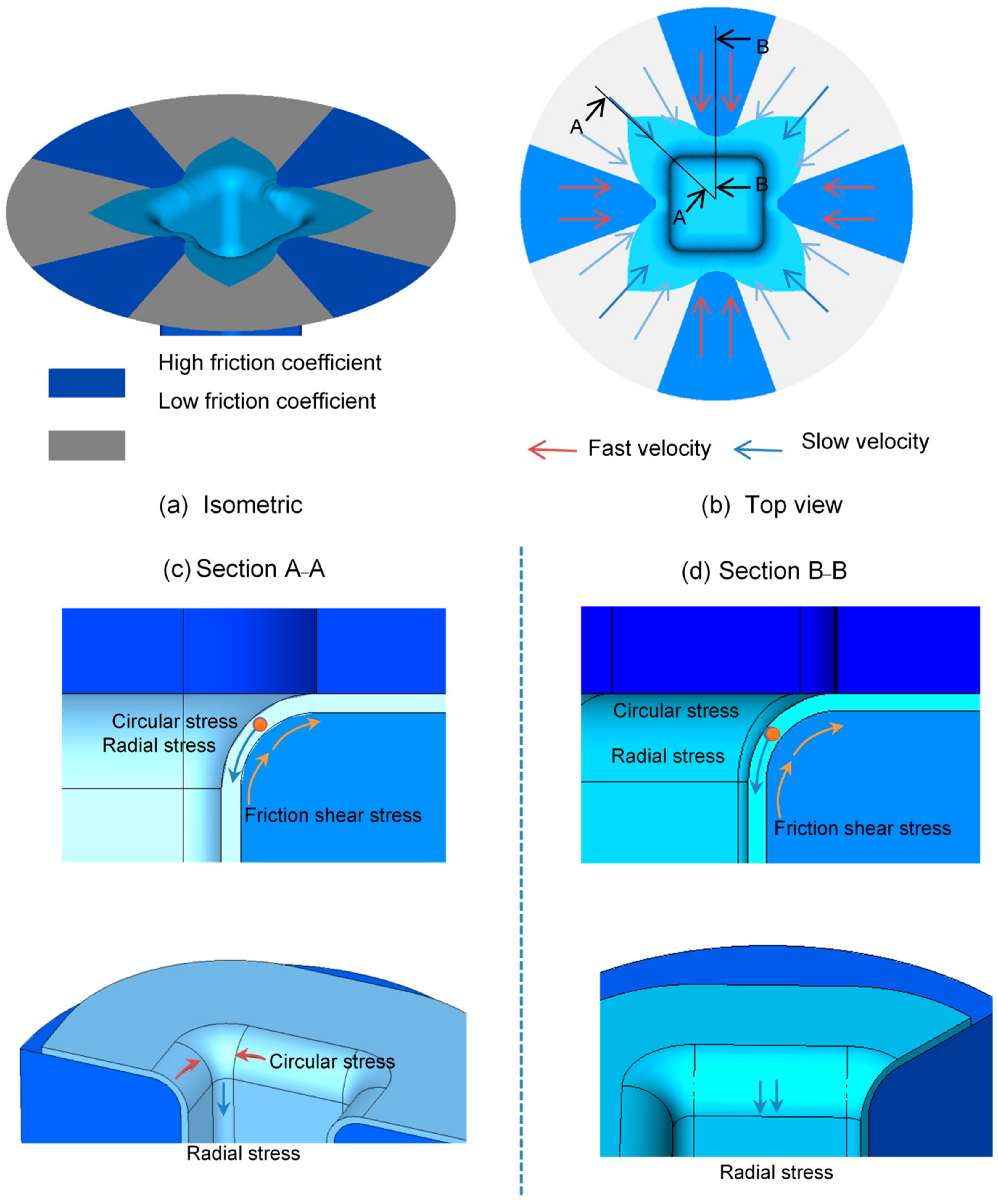
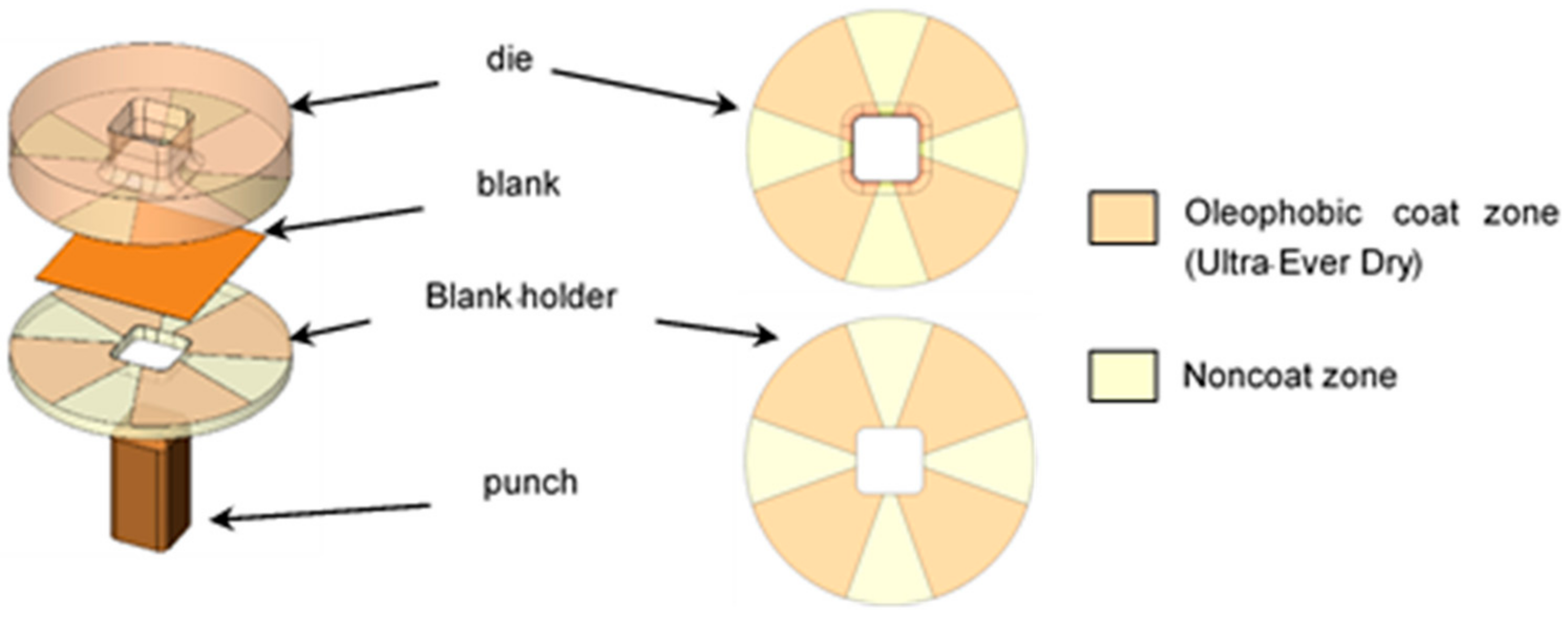
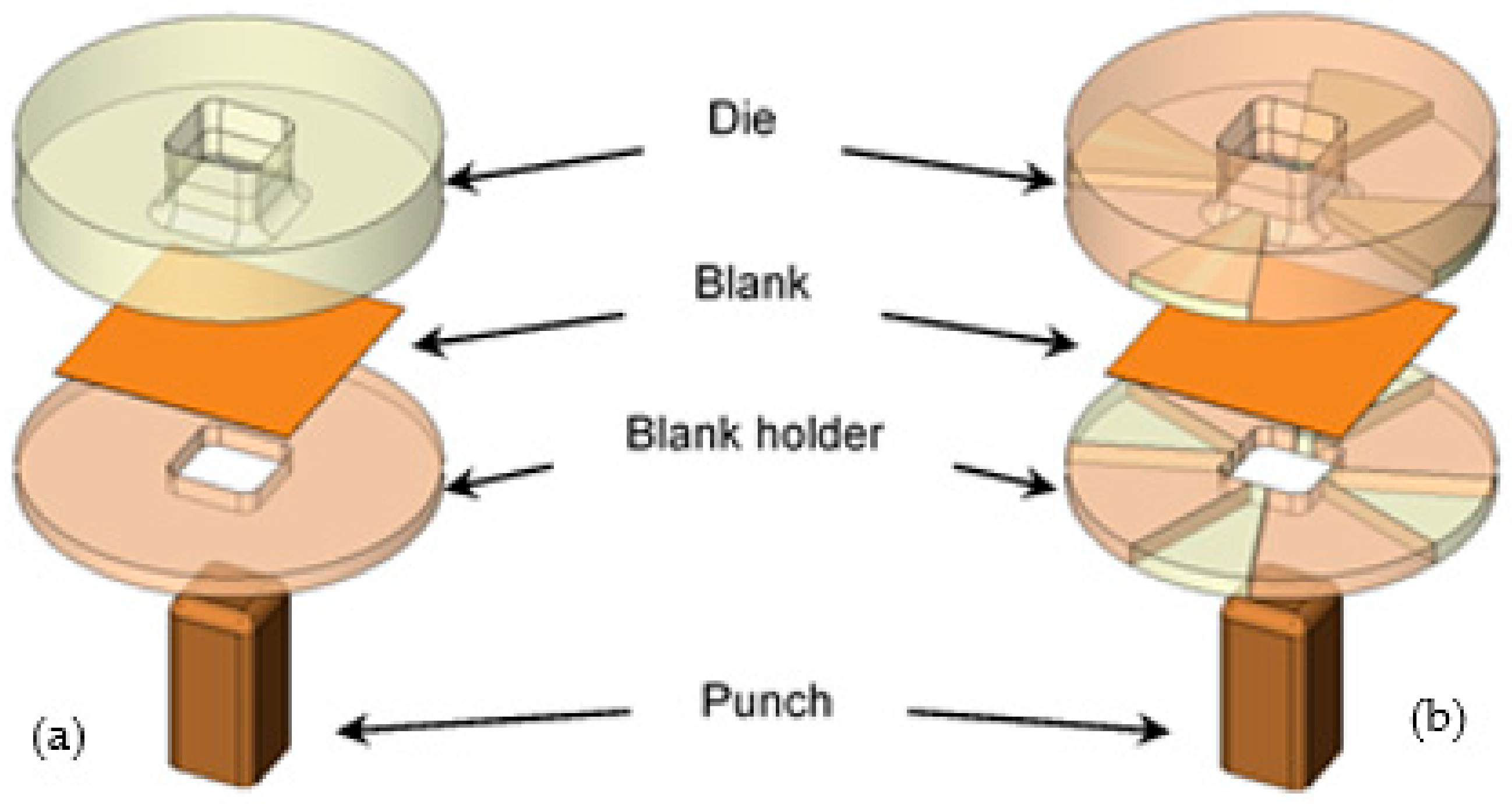

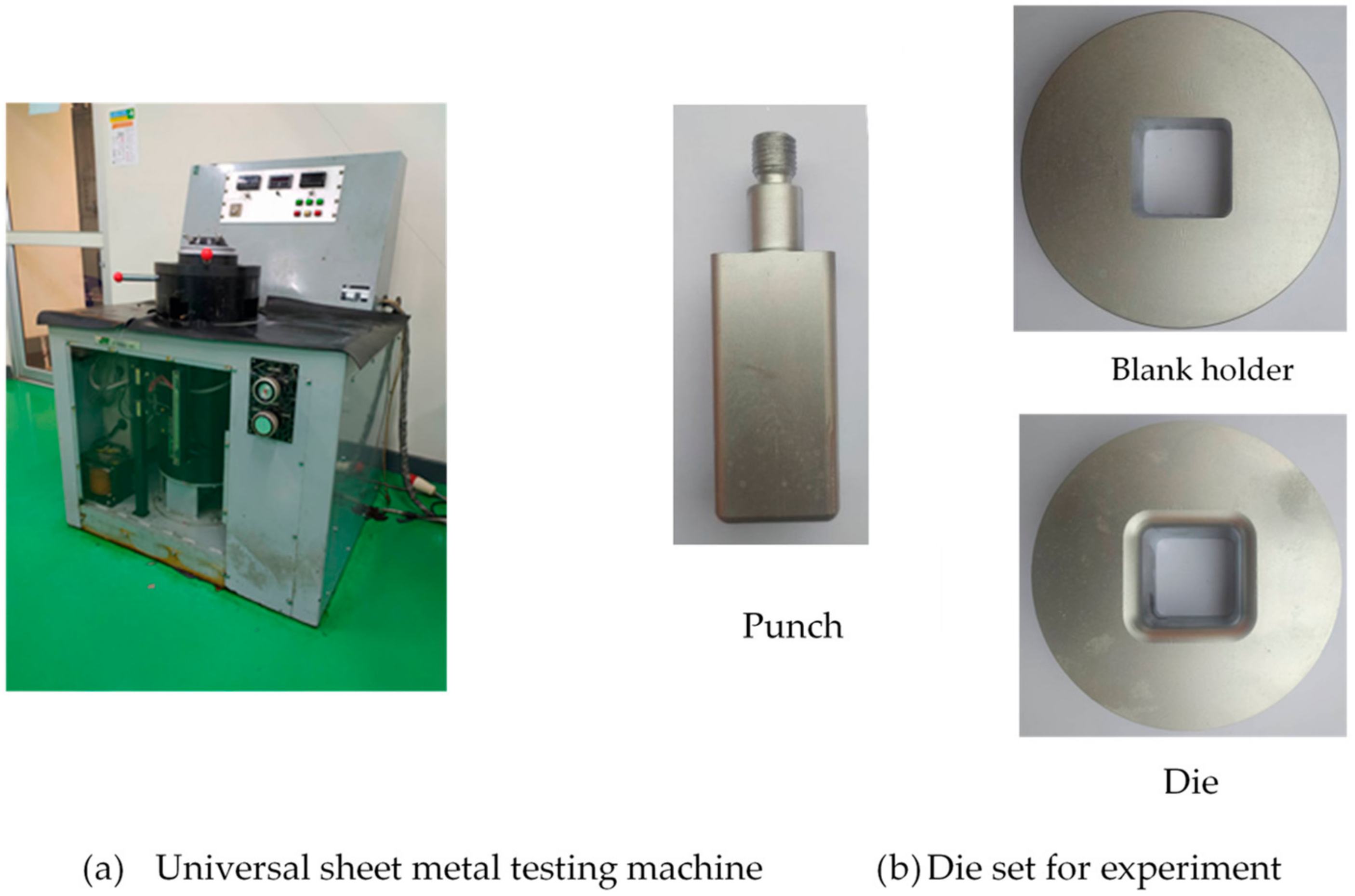

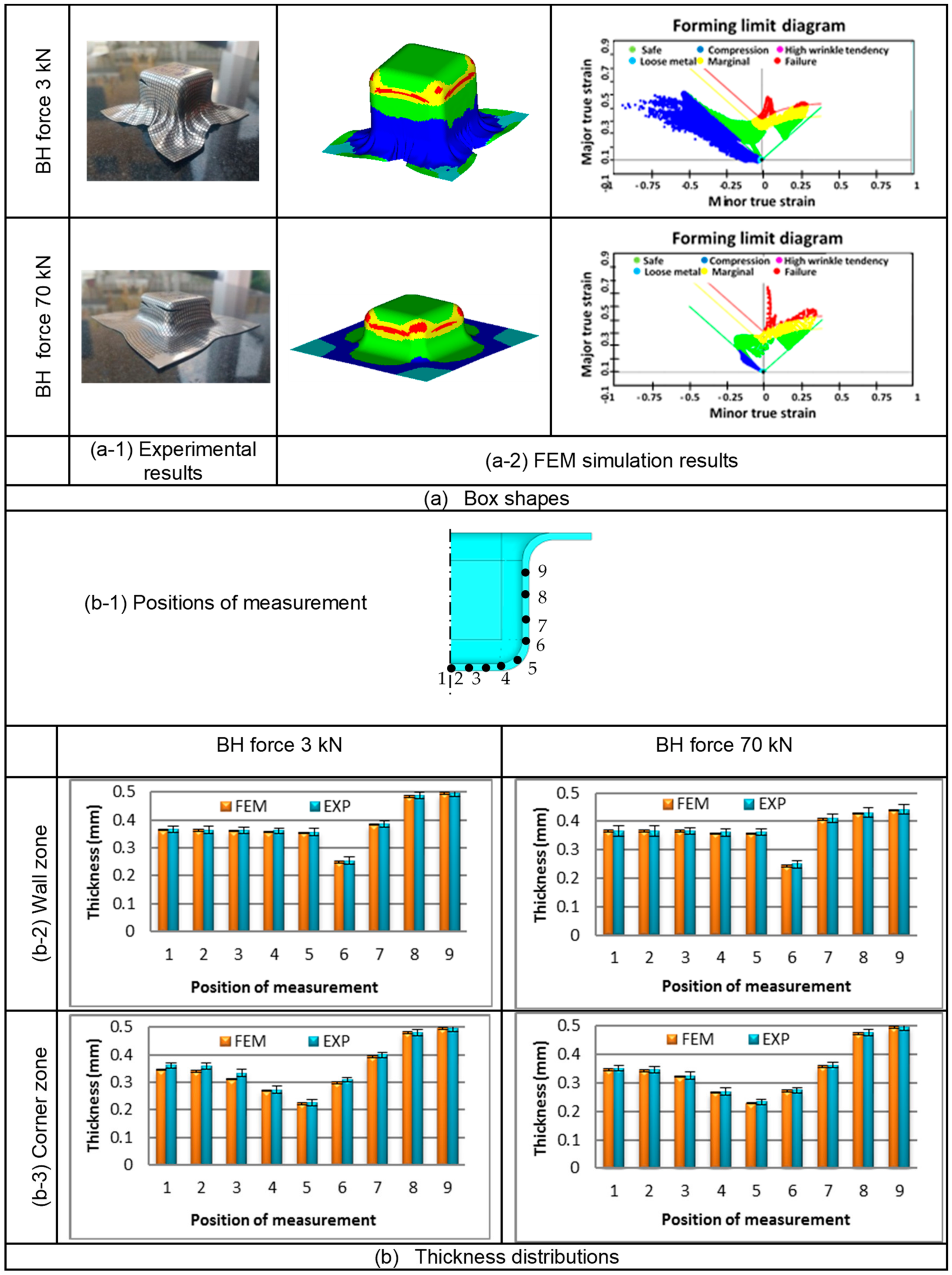
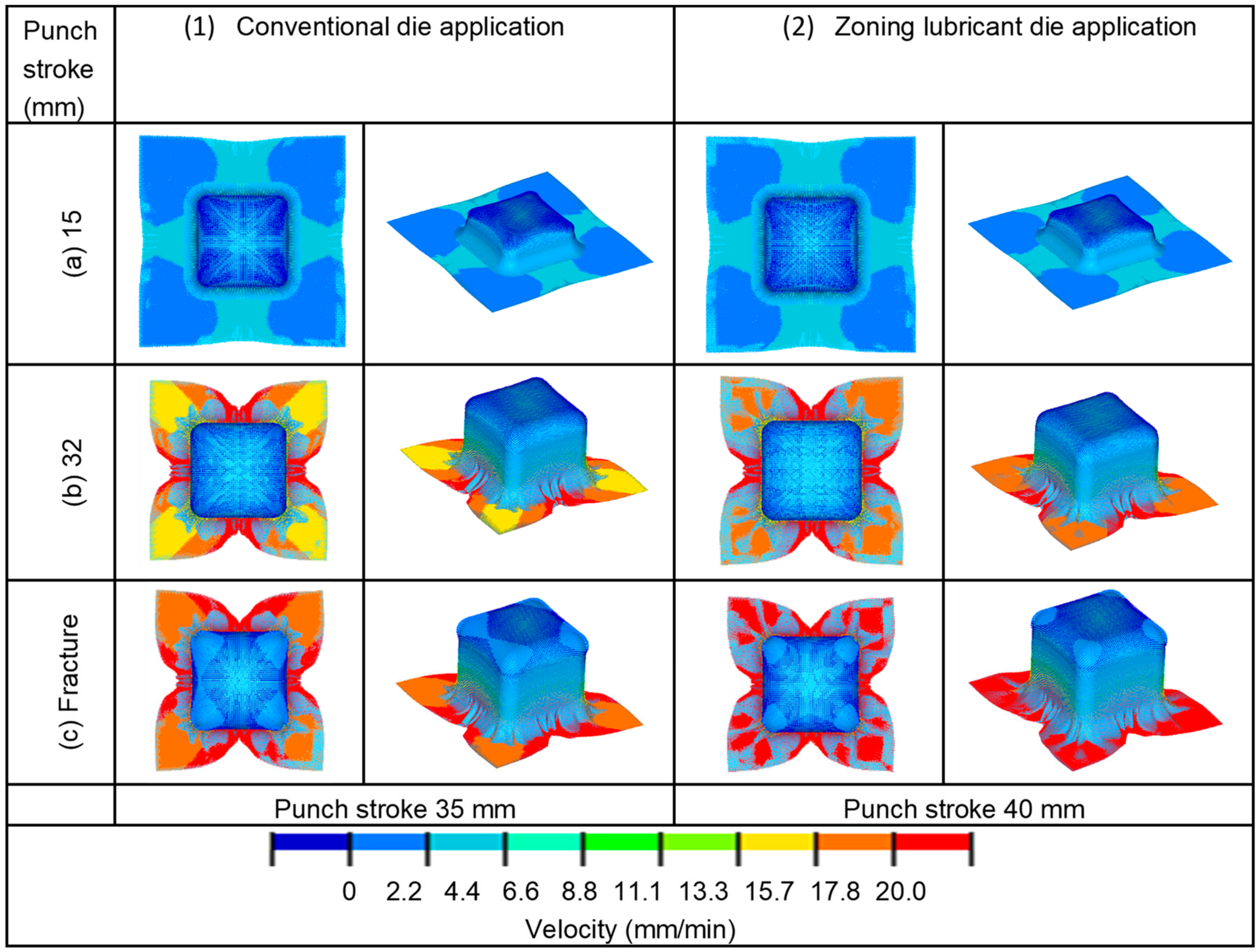
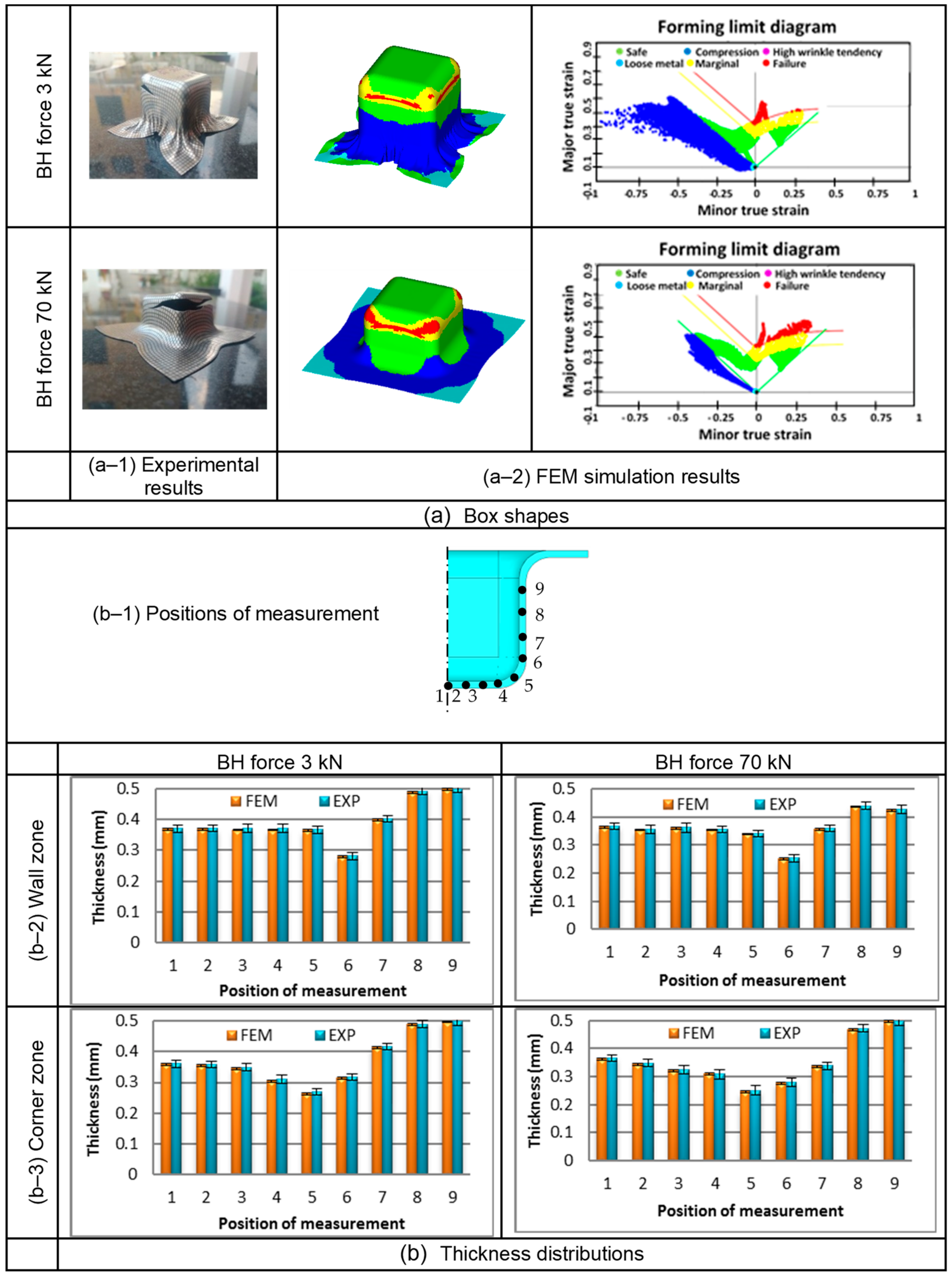
| Tool Geometry | Punch: Punch 40.0 mm × 40.0 mm, Punch radius 8.0 mm Die: Die 42.0 mm × 42.0 mm, Die radius 8.0 mm | |
| Clearance | 0.5 mm | |
| Punch speed | 30 mm/min | |
| Blank-holder force | 3 and 70 kN | |
| Blank size | 100 mm × 100 mm | |
| Thickness (t) | 0.5 mm | |
| Sheet material: Stainless steel (SUS304) | Tensile strength | 627.1 MPa |
| Yield strength | 283.8 MPa | |
| Elongation | 47.2% | |
| Young’s modulus | 190 GPa | |
| Poisson ratio | 0.3 | |
| Constitutive equation | ||
| Plastic strain ratio | 0°:0.985 45°:1.209 90°:1.055 | |
| Lubricant | Conventional Lubricant (Ilofom, TDN81): μ = 0.10 | |
| Oleophobic coat (Ultra-Ever Dry): μ = 0.03 | ||
| Bottom Coat (wt%) | Top Coat (wt%) | ||
|---|---|---|---|
| Xylenes | 36 | Acetone | 96–98 |
| t-Butyl Acetate | 36 | Silica | 2–4 |
| Acetone | 11 | Proprietary Additive | 1 |
| Proprietary Polymer | 16 | - | - |
| Proprietary Additives | 1 | - | - |
| Test Condition | Disc dimension | 20 mm (dia) |
| Linear Speed | 21 cm/s | |
| Acquisition rate | 50.0 Hz | |
| Normal load | 5.00 N |
Publisher’s Note: MDPI stays neutral with regard to jurisdictional claims in published maps and institutional affiliations. |
© 2021 by the authors. Licensee MDPI, Basel, Switzerland. This article is an open access article distributed under the terms and conditions of the Creative Commons Attribution (CC BY) license (https://creativecommons.org/licenses/by/4.0/).
Share and Cite
Phanitwong, W.; Sriborwornmongkol, J.; Thipprakmas, S. Zoning Lubricant Die Application for Improving Formability of Box-Shaped Deep Drawn Parts. Metals 2021, 11, 1015. https://doi.org/10.3390/met11071015
Phanitwong W, Sriborwornmongkol J, Thipprakmas S. Zoning Lubricant Die Application for Improving Formability of Box-Shaped Deep Drawn Parts. Metals. 2021; 11(7):1015. https://doi.org/10.3390/met11071015
Chicago/Turabian StylePhanitwong, Wiriyakorn, Juksawat Sriborwornmongkol, and Sutasn Thipprakmas. 2021. "Zoning Lubricant Die Application for Improving Formability of Box-Shaped Deep Drawn Parts" Metals 11, no. 7: 1015. https://doi.org/10.3390/met11071015
APA StylePhanitwong, W., Sriborwornmongkol, J., & Thipprakmas, S. (2021). Zoning Lubricant Die Application for Improving Formability of Box-Shaped Deep Drawn Parts. Metals, 11(7), 1015. https://doi.org/10.3390/met11071015






